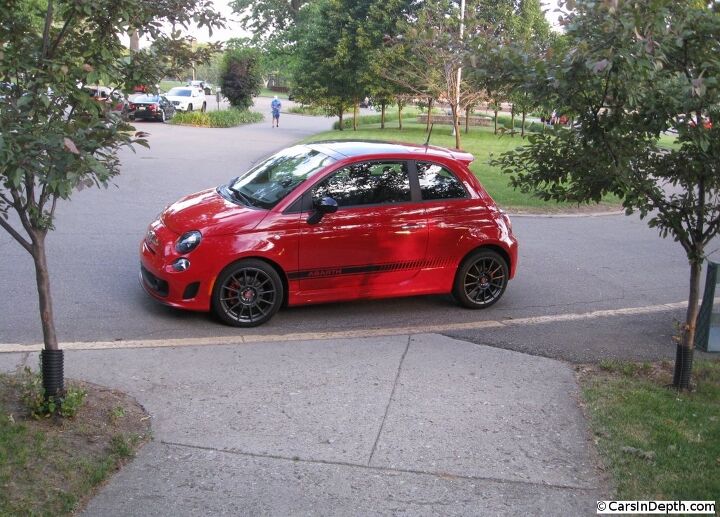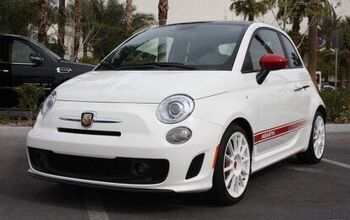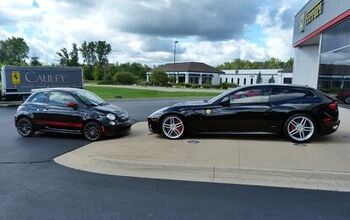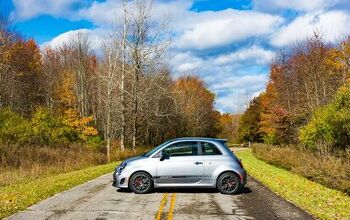Review: 2015 Fiat 500 Abarth

Is there a car enthusiast whose pulse does not quicken when he or she hears the brrrap brap of the exhaust when the North American spec Fiat Abarth fires up? TTAC’s managing editor Derek Kreindler is correct, the Abarth does indeed sound faster than it actually is, but it still sounds glorious. Don’t tell me that an inline four can’t sound as exciting as a V8 or even a V12. Saying that an eight or a twelve “sounds better” than a four is like saying that a big band sounds better than a trio, as if you can’t enjoy both Duke Ellington and Cream.
Not only does it sound good when you start it up, I suspect that the ECU on the Abarth’s turbocharged and twin-intercooled 1.4 liter motor may even be deliberately dumping a little unburned fuel into the exhaust manifold on throttle overruns. You start looking for tunnels and concrete walls just to hear the sound reverberate. Of course, while the Fiat Abarth playing the Rice Krispies Symphony may bring a smile to the face of just about any car enthusiast, to worshipers of Gaia I fear that the little Italian car by way of Auburn Hills and Mexico sounds like the death rattles of a million baby polar bears. Well, as they say, one person’s music is another person’s turn that crap down. That exhaust isn’t the only thing about the little car that will make you smile.
Besides an exhaust that will never ever let you sneak out of the house at night unnoticed, the Abarth would never be described as inconspicuous. Rosso red paint, worthy of an Italian car, and large Abarth logos and scorpions all over the joint (it’s hard to find a Fiat logo on the Abarth), added to the big wheels, wide tires and aggressive stance will surely get you noticed.
For a car with two Italian brand names, it might come as some surprise that, as alluded to above, the U.S. market Fiat Abarth was developed by Chrysler’s team in the Detroit area and assembled in Mexico. While that might seem ironic for a car marketed with Italian brio, I think the car’s global background fits the history of Carlo Abarth well. Born Karl Abarth, to a Jewish family in Austria, he made a name for himself tuning and racing motorcycles. Injuries from a racing accident and the Nazi Anschluss in Austria stopped his racing career and life in Austria. He spent the duration of World War II in Yugoslavia. After the war, he moved to Italy, where he had ties dating to the early 1930s. He had great connections. Abarth personally knew the great racer Tazio Nuvolari and was friends with Ferry Porsche, Ferdinand Porsche’s son. As a matter of fact, Abarth married the secretary of Ferry Porsche’s brother-in-law Anton Piëch. In Italy he was one of the founders of the influential Cisitalia company. When that firm dissolved, he started Abarth & C. S.p.A in 1949. In 1952 the Abarth firm started a relationship with Fiat, tuning and racing their cars and selling performance accessories, that culminated in the automaker’s acquisition of the Abarth company in 1971.
While Carlo didn’t have much to do with the development of the car that bears his name, the team in Auburn Hills produced a car that’s great fun to drive in most real world driving situations. Though I have a fondness for the large American sedans of my youth, I’ve always loved little cars. One of the first cars that I drove was my brother’s ’63 Mini Cooper. In many ways the Fiat Abarth is a spiritual descendant of that car, a car that took the inherent goodness of a FWD econobox and made it even better. When I drove the base Fiat 500 as a rental car, I enjoyed my week with it, though it was obviously a cheap car. Tossing it around a corner, even getting the rear end to wag a little, you could tell the base Fiat wanted to handle. The Abarth iteration of the 500 fulfills that promise.
The Abarth version turns up the wick on how the 500 sticks. It has all the grip you’d ever need for any kind of enthusiastic street driving. Much of that can be attributed to the 205/40R17 Pirelli PZero “three season” tires, but there’s also been some careful attention to suspension tuning. The Abarth feels both more dampened and more supple than the base car. Also, considering that the Fiat has a very short wheelbase, the Abarth had a better ride than the Dodge Dart GT that I drove the week before. Since both the Dart GT and the U.S. market Fiat Abarth were developed by Chrysler’s team in Auburn Hills from Italian platforms, it’s somewhat surprising that the larger Alfa Romeo based Dart has a more bone shaking ride than the Abarth.
Though the Abarth has power steering, it’s not a car to one hand it around town. Make the shift and put your right hand back on the wheel. Steering feel through the chunky steering wheel was uniformly heavy. Speaking of chunky steering wheels, if I can be allowed a slight digression, just because a car is intended for driving in a sporting manner doesn’t mean it needs a steering wheel whose rim is two inches in diameter. Okay, so that’s an exaggeration, but along with the proliferation of flat-bottomed steering wheels, we’ve seen the grips on steering wheels getting fatter and fatter, so much so that someone like me, who has relatively small hands, sometimes finds some of them, like the one on the Fiat Abarth, a bit too chunky to handle comfortably, sort of how I feel about a Glock 9mm.
You had better have a good grip on that chunky steering wheel because, as mentioned, the Fiat Abarth is not a car to casually drive with one hand lightly on the wheel. The steering is fairly heavily weighted, though it lightens up a bit on the highway. Actually, on the interstates the Abarth is relatively comfortable for a short wheelbase car that’s bound to be pitching up and down. Another reason for keeping a firm hand on the wheel is that, as with some other front wheel drive based cars of European origin, the Fiat Abarth has a tendency to follow linear road irregularities. It dances a bit on grooved pavement and it will track asphalt that has been worn into wide grooves. That phenomenon is exaggerated with heavy braking or if you manage to elicit some torque steer when accelerating.
For the most part, though, torque steer wasn’t particularly noticeable. I also didn’t notice much turbo lag as some have reported. It’s there if you’re the sort who redlines a lot but it really wasn’t an issue in normal around the town driving. I like small cars and I’ve been an enthusiastic supporter of front wheel drive since I first drove that ’63 Mini. Combine small size, good handling and sufficient power and you have a perfect tool for the cut and thrust of urban and suburban driving. If the hole in traffic is big enough for the Abarth, the 1.4 turbo will get you there.
While it’s not the fastest car on the street, not as quick, let’s say, as the Ford Fiesta ST, my personal feeling is that it’s fast enough for just about any kind of enthusiastic driving outside of the track. Whether you end up preferring the Abarth, the FiST, or the Toyota/Scion/Subaru sports coupe is a matter of taste and driving styles. No matter which you would choose, though, you’d have fun with the Abarth.
It’s fine in the city and out on the highway you can cruise all day long at just about any speed that’s prudent, and even some imprudent speeds as well. Top speed is specified as a governed 129 mph and while I didn’t get the Abarth that high on the 160 mph speedometer, the indicated 117 I reached at Schreiber’s Secret High Speed Test Facility let me believe that the specs are accurate. The engine was losing some steam as it wound out in the top gear of the upgraded 5 speed transmission, but it still should be able to see 129 if the straightaway is long enough. I should report, however, that after the high speed run I did notice some odd odors from something heating up under the hood.
For the most part, I genuinely liked the Fiat Abarth, so much so that as the week with it wound down and I used up the free tank of gas that it came with (see below for observed mpgs), I ate the expense of buying premium gasoline for it, rather than use my daily driver, which takes 87 octane. It’s an eager puppy of a car that’s quite easy to like.
There were some things, though, that I didn’t like. Most of them had to do with the fact that it’s based on a cheap economy car that’s getting a bit long in the tooth. The modern day 500 was introduced in Europe in 2007, a couple of product cycles ago. I don’t like the way the concentric instrument cluster is laid out, and while it’s nice to have the auxiliary boost gauge that lets you know that the convenient Sport mode button on the center stack really does make a difference how the engine is mapped, the indicator light telling you to shift up doesn’t seem to follow any logic that I’ve learned in over 40 years of driving a stick shift.
Also, the arm rests for the front seats are located so that when both of them are down, you can’t reach the parking brake, a hassle in a car with a manual gearbox. I don’t know if it’s a design feature or a flaw, but the driver’s side arm rest has sagged a bit on both Fiat 500s that I’ve driven, which adds to the impression that the Abarth is based on a cheap car.
Speaking of manual transmissions, the dash mounted 5 speed gear selector on the Abarth has fairly short throws, but the low mileage press car’s shifter was not ideal. Trying to downshift from 5th to 3rd was an iffy proposition and I even had a hard time finding 3rd on an upshift or two. On the other hand, the clutch was very smooth and easy to use. So easy that I used it to start teaching my daughter how to drive a stick (note the indefinite article, “drive stick” gets you a demerit in Language Arts) and she was able to get the little car rolling around the parking lot without stalling it on only the third try.
Can I say that the bass from the Beats by Dr. Dre audio system sounded like it had some coloration?
As stickered out on the Monroney sheet, the test car was a tick over $30K, $30,004 including an $800 destination charge. The base Abarth is $22,095 and in my estimation much of the $8,000 in options wouldn’t be well spent, at least if I was buying the car. The $1,200 “performance” leather trimmed high back bucket seats are best left unchecked on the options list. They don’t provide you with enough side bolstering for the car’s handling abilities. They were less effective in that regard than the seats on the Dodge Dart GT. Save the money and buy an aftermarket performance driver’s seat instead. The audio system was $700 and comes with the Beats brand. After VW’s deal to label Panasonic stereo systems with Fender’s brand, I’m not so naive as to think that Dr. Dre had anything to do with that sound system beyond getting paid to put the Beats brand on it. Both of the Beats audio systems in Fiat Chrysler cars that I’ve tested have been unimpressive and please don’t call me a racist if I say that there was more than a little coloration in the bass (besides, I think Dr. Dre sold that business to Sony for really big bucks). The $600 tacked on TomTom Blue&Me nav system also didn’t seem like a prudent purchase in light of what you have on your phone already. It also was not easy for me to use. On the plus side, my Android phone reliably hooked up to the car for both phone and music.
A half century of high performance minicar progress. The Abarth’s 17″ rims are about as big around as an original 1963 Mini Cooper’s tires, and that brake rotor and caliper would never fit inside the Mini’s 10″ wheels.
I also wouldn’t pop for the $1,300 power sunroof, but I concede that if you’re going to drive a car that is supposed to represent Italian spirit, you might want some al fresco driving. For an almost fully open air Abarth experience, the model is available as a cabriolet (the Fiat 500 convertible retains the side roof rails). The 17 by 7 inch forged aluminum “hyper black” wheels are an easier call. They cost as much as the sunroof does, but they probably contribute to the Abarth’s fine handling, so they’re probably worth the price. Just for grins I dug the spare tire out of the boot of the Mini Cooper (which my brother is storing here). In half a century, the wheel size on a tiny car has grown from 10″ to 17″. The rims on the Abarth as as big or bigger than then original Mini Cooper’s whole wheel and tire assembly.
The Abarth has a proper and substantial false pedal that comes in handy to brace yourself with the Fiat’s enthusiastic handling. Full gallery here
The upshot is that for less than $25,000 (A/C is standard) you can get a decently equipped Fiat Abarth that is likely to put a big smile on your face. It may be based on a cheap car, but the Abarth is not an economy car. I got a pretty consistent 24.7 miles per gallon of premium gasoline. That’s fine for a performance car but far from what the base 500 can get. As an aside, why do they sell cars that require 91 octane while all the gas stations around here only sell 93? Okay, so filling half and half with 89 and 93 gets the right R+M/2 rating, but it’s either the hassle of dong the math and pumping twice or paying more for fuel than you really have to pay. In addition to requiring premium fuel, the Fiat Abarth requires the use of synthetic engine lubricating oil.
You can haul your little ones around in the back seat but they won’t have much leg room. Full gallery here
Like the Dodge Dart, the Fiat Abarth doesn’t come with a spare tire, but rather an electric pump with it’s own can of tire sealant, in this case stored under the driver’s seat, taking up some of the rear seat passenger’s already not very generous foot room.
An electric tire pump and ‘fix a flat’ sealant replaces the spare tire and it’s stored under the driver’s seat. Full gallery here.
In conclusion, the Abarth is just one of a number of fairly desirable enthusiast cars that cost less than $30,000. Offhand there’s the aforementioned Fiesta ST, its big brother the Focus ST, the Toyobaru GT-86/FR-S/BRZ siblings, and I’m sure you can suggest a few more. While they may not be muscle car quick off the line, they all have enough pep to be fun to drive on the street and they all have competent chassis, steering and braking systems that make them fun to drive. They’re not perfect, you can find something to criticize with all of them. They are, after all, built to price points. However, they’re all great fun to drive and if you can’t find one that you could live with and enjoy, either you’ve gotten used to much more expensive cars, or you’re not much of a car enthusiast. Actually, since some of the highest praise for the current generation of entry level sporting motor cars has come from people who get exposed to a lot of very pricey, very high performance automobiles, like some of my colleagues in the car writing biz, I’d say that price doesn’t really matter. There are lot of cars that are great fun to drive, including the Fiat Abarth, and it’s a great time to be a car enthusiast.
The model that I tested was from the 2014 model year. Since then FCA has made the Fiat Abarth available with an automatic transmission.
FCA supplied the car, insurance and a tank of premium gas.
Disclosure: It’s the policy of The Truth About Cars is to reveal to our readers any damage that we do to press cars. Our former editor in chief pro tempore even published an editorial on the topic. I’m not sure if he tempted the fates with that editorial, but I’m sad to say that I damaged one of the Fiat Abarth’s 17″ rims. I’d like to at least be able to say that I went into a corner a little bit hot and clipped the apex, but the truth is that I was lazy and inattentive on a street on which I’ve driven thousands of times before and managed to scrape a curb. The damage was likely just cosmetic but in any case I reported it to our editors and the car company, and now you. You can never be too sure of yourself and you can always learn something that will improve your driving.
Ronnie Schreiber edits Cars In Depth, a realistic perspective on cars & car culture and the original 3D car site. If you found this post worthwhile, you can get a parallax view at Cars In Depth. If the 3D thing freaks you out, don’t worry, all the photo and video players in use at the site have mono options. Thanks for reading – RJS

Ronnie Schreiber edits Cars In Depth, the original 3D car site.
More by Ronnie Schreiber
Latest Car Reviews
Read moreLatest Product Reviews
Read moreRecent Comments
- 1995 SC I will say that year 29 has been a little spendy on my car (Motor Mounts, Injectors and a Supercharger Service since it had to come off for the injectors, ABS Pump and the tool to cycle the valves to bleed the system, Front Calipers, rear pinion seal, transmission service with a new pan that has a drain, a gaggle of capacitors to fix the ride control module and a replacement amplifier for the stereo. Still needs an exhaust manifold gasket. The front end got serviced in year 28. On the plus side blank cassettes are increasingly easy to find so I have a solid collection of 90 minute playlists.
- MaintenanceCosts My own experiences with, well, maintenance costs:Chevy Bolt, ownership from new to 4.5 years, ~$400*Toyota Highlander Hybrid, ownership from 3.5 to 8 years, ~$2400BMW 335i Convertible, ownership from 11.5 to 13 years, ~$1200Acura Legend, ownership from 20 to 29 years, ~$11,500***Includes a new 12V battery and a set of wiper blades. In fairness, bigger bills for coolant and tire replacement are coming in year 5.**Includes replacement of all rubber parts, rebuild of entire suspension and steering system, and conversion of car to OEM 16" wheel set, among other things
- Jeff Tesla should not be allowed to call its system Full Self-Driving. Very dangerous and misleading.
- Slavuta America, the evil totalitarian police state
- Steve Biro I have news for everybody: I don't blame any of you for worrying about the "gummint" monitoring you... but you should be far more concerned about private industry doing the same thing.
















































Comments
Join the conversation
I get a little miffed every time an automotive reviewer whines about a performance car which requires premium fuel. If you own a performance car, premium fuel is part of the price you pay for...performance! On a small car like this with a ~12 gallon tank, you're probably talking about $3-$4 on a fill-up. How about skipping Starbucks for one day a week and stop whining?
The key with this car isn't "miles per gallon" but "smiles per mile". My other car is a Lotus Elise so to me the Abarth is a luxury car. I got mine for $4K off sticker and with all the major options I financed around $22K. Recently I've seen dealers in the DFW area offer $5K off sticker so the comparison of the Abarth with $30K cars is unfair since you'll probably only pay $18-23K